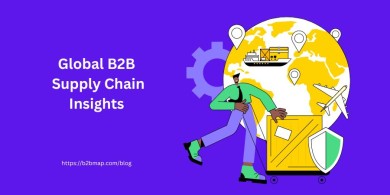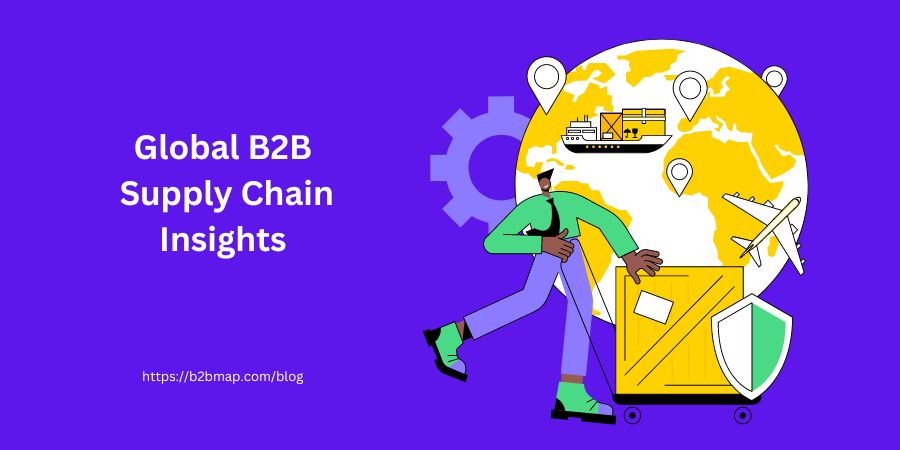
In the increasingly interconnected global trade, businesses face a multitude of challenges when managing their B2B supply chains on a global scale. From navigating complex logistics and transportation networks to ensuring effective communication across different cultures and time zones, the obstacles can seem daunting. That's why understanding and addressing the common challenges in global B2B supply chains is crucial for companies to maintain a competitive edge.
This comprehensive guide explores the key challenges faced by businesses operating in global B2B supply chains and provides practical insights and real-life examples to help overcome these hurdles. We delve into the intricacies of logistics and transportation, highlighting the complexities of customs regulations, coordinating diverse transportation modes, and ensuring timely deliveries. Effective communication and collaboration are also explored, emphasizing the importance of bridging language barriers, understanding cultural nuances, and finding efficient ways to collaborate across borders.
Challenges in Global B2B Supply Chain
- Logistics and transportation
- Communication and collaboration
- Supply chain visibility and transparency
- Compliance and regulatory issues
- Supply chain disruptions
- Supplier management and risk mitigation
- Inventory management
- Technology integration
- Cost optimization
- Sustainability and ethical considerations
Supply chain visibility and transparency are vital for businesses to optimize their global supply chains. We shed light on the difficulties of gaining full visibility from raw material sourcing to final product delivery, emphasizing the repercussions of limited transparency on inventory management and operational efficiency. Compliance and regulatory issues are also discussed, underscoring the challenges of adhering to varying regulations, certifications, and quality standards across different countries.
The guide also tackles the ever-present risk of supply chain disruptions, be it natural disasters, political instability, or unforeseen events. Companies learn strategies to develop robust risk management plans, diversify their supplier base, and ensure business continuity in the face of disruption.

Logistics and transportation:
Managing the movement of goods across different countries involves navigating various challenges. Customs regulations and procedures can be complex and time-consuming, requiring proper documentation and compliance with specific requirements. Coordinating multiple modes of transportation, such as air, sea, road, and rail, adds complexity to logistics operations. Ensuring timely delivery can be challenging due to potential delays at ports, congested transportation routes, or unexpected disruptions. For example, during the COVID-19 pandemic, restrictions on international travel and transportation impacted global logistics, leading to delays in the delivery of goods.
Communication and collaboration:
Effective communication and collaboration are essential for the smooth functioning of global B2B supply chains. Language barriers can impede clear communication and understanding between stakeholders from different countries. Cultural differences in communication styles, business practices, and decision-making processes can also create challenges. Additionally, time zone variations make real-time collaboration and decision-making more difficult. To overcome these challenges, companies may employ multilingual staff, utilize translation services, and leverage technology platforms that facilitate communication and collaboration. For instance, video conferencing tools and project management software enable stakeholders from different regions to collaborate effectively.
Supply chain visibility and transparency:
Gaining visibility into the entire supply chain is crucial for efficient operations. However, achieving end-to-end visibility and transparency can be challenging in global B2B supply chains that involve multiple parties, locations, and systems. Lack of visibility can result in delays, increased costs, and difficulties in managing inventory levels. Companies strive to have visibility from the sourcing of raw materials to the final delivery of products to customers. By leveraging technologies such as IoT sensors, RFID tags, and supply chain management systems, companies can track and monitor the movement of goods, inventory levels, and production status. This enables better decision-making, improved inventory management, and timely identification and resolution of issues.
Compliance and regulatory issues:
Compliance with regulations, certifications, and quality standards is vital in global supply chain operations. Each country has its own set of regulations related to product safety, labeling requirements, environmental standards, and labor practices. Ensuring compliance across multiple jurisdictions adds complexity to supply chain operations. Non-compliance can result in fines, penalties, legal issues, and reputational damage. To address compliance challenges, companies need to stay updated on regulatory changes, maintain robust documentation and record-keeping systems, conduct regular audits of suppliers, and implement quality management systems. For example, the European Union's Restriction of Hazardous Substances (RoHS) directive imposes restrictions on the use of certain hazardous substances in electrical and electronic equipment, requiring companies to ensure compliance throughout their supply chains.
Supply chain disruptions:
Global supply chains are vulnerable to various disruptions that can significantly impact operations. Natural disasters such as earthquakes, tsunamis, hurricanes, or floods can damage transportation infrastructure, disrupt production facilities, or cause delays in the delivery of goods. Political instability, trade disputes, or unexpected events like the COVID-19 pandemic can also disrupt supply chains by disrupting transportation routes, limiting the availability of raw materials, or causing labor shortages. To mitigate the impact of disruptions, companies adopt strategies such as diversifying suppliers, maintaining safety stock, developing contingency plans, and implementing risk management strategies. For instance, the 2011 earthquake and tsunami in Japan disrupted global supply chains due to the significant damage caused to manufacturing facilities and transportation infrastructure, leading to shortages of critical components in various industries worldwide.
Supplier management and risk mitigation:
Managing a network of suppliers across different countries involves assessing and mitigating risks associated with supplier reliability, quality, ethical practices, and financial stability. By relying on a single supplier, a company becomes more vulnerable to disruptions. For instance, the global semiconductor shortage in 2020 and 2021 impacted various industries due to the concentration of semiconductor production in a few countries and disruptions in the supply chain. Companies need to diversify their supplier base, conduct thorough supplier assessments, and establish contingency plans to mitigate risks and ensure continuity of supply.
Inventory management:
Balancing inventory levels across different locations in global supply chains is crucial to meet demand while minimizing excess inventory or stockouts. Accurate demand forecasting across diverse markets is challenging due to factors like seasonality, regional preferences, and evolving consumer behavior. For example, a retailer with global operations must consider variations in demand patterns across different countries and adapt inventory levels accordingly. Leveraging data analytics, market research, and demand planning tools can help optimize inventory management and ensure efficient supply chain operations
Technology integration:
Adopting and integrating advanced technologies such as supply chain management software, data analytics, and IoT devices can enhance visibility and efficiency in global supply chains. However, implementing and managing these technologies across diverse regions can be complex. Companies must navigate challenges related to varying IT infrastructure, data privacy regulations, and interoperability of systems. For instance, implementing a unified supply chain management system across multiple countries may require customization to comply with local regulations or integration with existing legacy systems. Collaboration with technology partners and thorough change management processes are essential for successful technology integration
Cost optimization:
Managing costs across global supply chains involves considering various factors such as transportation expenses, tariffs, customs duties, taxes, currency exchange rates, and labor costs. Balancing cost efficiencies with maintaining product quality and satisfying customer expectations is an ongoing challenge. Fluctuating oil prices, for example, can significantly impact transportation costs and overall supply chain expenses. Companies employ strategies like optimizing transportation routes, consolidating shipments, negotiating favorable contracts, and implementing lean practices to optimize costs while ensuring the reliability and speed of supply chain operations.
Sustainability and ethical considerations:
Meeting sustainability goals, ensuring ethical sourcing and manufacturing practices, and minimizing the environmental impact of global supply chains have become increasingly important. However, achieving these objectives in complex, multinational supply chains presents challenges. For instance, companies may face difficulties in verifying and monitoring compliance with environmental regulations and ethical standards across their supplier networks. Implementing sustainable practices and promoting responsible sourcing requires close collaboration with suppliers, rigorous audits, and transparency throughout the supply chain. Companies may also explore innovations such as sustainable packaging, renewable energy adoption, and circular economy principles to drive sustainability in their supply chains.
In conclusion, global B2B supply chains present a host of challenges that businesses must overcome to ensure smooth operations, customer satisfaction, and long-term success. From logistics and transportation complexities to communication barriers, compliance issues, and supply chain disruptions, these challenges require proactive strategies and effective management.
However, businesses can navigate these challenges by adopting a proactive approach. Diversifying supplier networks, establishing robust risk management plans, and leveraging advanced technologies for visibility and efficiency are key steps toward building resilient supply chains. Accurate demand forecasting, effective inventory management, and cost optimization strategies can help businesses strike the right balance between meeting customer demands and minimizing costs.
Furthermore, addressing sustainability and ethical considerations is crucial in today's business landscape. By implementing responsible sourcing practices, reducing environmental impact, and ensuring ethical manufacturing, businesses can not only meet regulatory requirements but also earn the trust and loyalty of customers who prioritize ethical and sustainable practices.
Ultimately, successfully managing global B2B supply chains requires continuous adaptation, collaboration, and innovation. By staying abreast of industry trends, embracing technology, and fostering strong relationships with stakeholders, businesses can overcome these challenges and position themselves for growth in the global marketplace.
With a comprehensive understanding of the common challenges discussed in this guide and the implementation of effective strategies, businesses can build robust, efficient, and sustainable global supply chains that drive success in today's highly connected world.
Published: May 22, 2023
Grow Your Business Online
Use Our Buyer Seller B2B Marketplace to Source Your Product or Increase Sells & Revenue by Getting New Buyers.